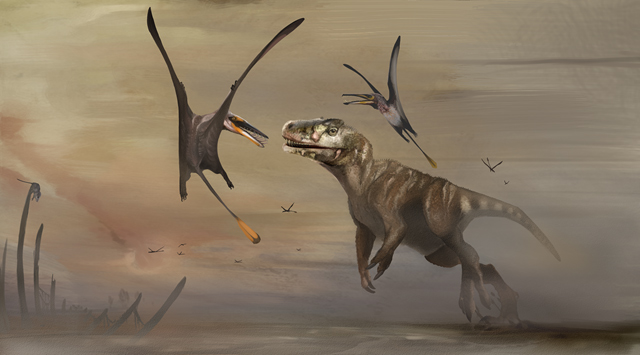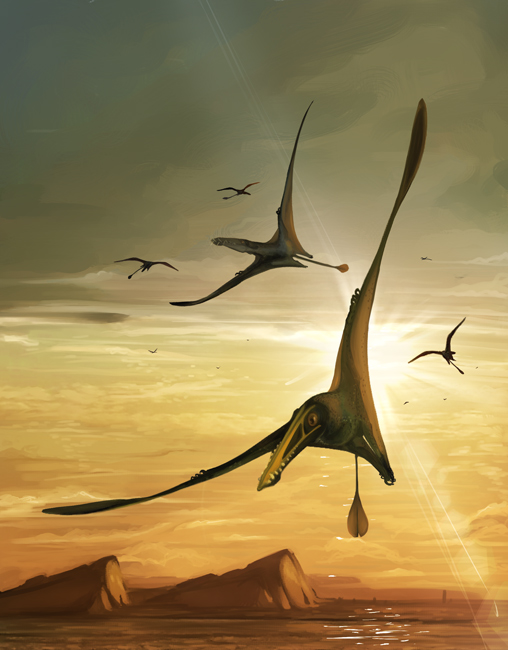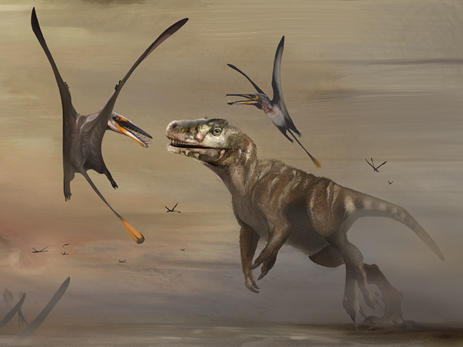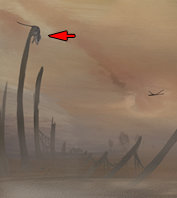When a new prehistoric animal is named and described in a scientific paper, often, an illustration featuring the new discovery is commissioned so that readers and viewers of any subsequent media release can get an impression of what the creature might have looked like. These life reconstructions show the animal in context, providing an insight into the palaeoenvironment and sometimes also highlighting contemporaneous species that shared the same habitat.
Illustrating a Scientific Paper
These, frequently stunning illustrations are carefully conceived. Great care is taken to reflect the scientific evidence, however, the artist has some licence when it comes to considering the landscape, the choice of colours and the motif of the artwork.
Sometimes the person responsible for the scientific illustration is one of the authors of the study. For example, the artwork supporting the media release on the recently described rhamphorhynchid pterosaur from the Isle of Skye (Dearc sgiathanach), was created by the lead author Natalia Jagielska, a PhD student at the School of GeoSciences, University of Edinburgh.

Everything Dinosaur asked the artist what inspired and influenced her when it came to illustrating the newly described Scottish pterosaur.
Reflecting Scientific Evidence in Palaeoart
Natalia explained that she was inspired by Scottish birds, both those in Edinburgh, where the D. sgiathanach fossil material is stored and also the many seabirds synonymous with the Isle of Skye (where the fossil was found). Gannets are common on the island. They have a similar wingspan to that estimated for Dearc sgiathanach. With their long crania, robust neck and slender wings, these piscivores could be regarded as occupying a similar niche in the marine based ecosystem as the rhamphorhynchids.
“I wanted to form this connection between contemporary local fauna and ancient fauna”, Natalia commented. “I also added a splash of blue hues and yellows on the head in some reconstructions, as a nod to its Scottish origin and the Scottish flag”.

Setting the Scene for a Jurassic Pterosaur
The background into which the life reconstruction is inserted can also help to convey important information relating to geology and the ancient environment. The rugged cliffs (above), reflect the famous steep cliffs of Skye and link the Jurassic landscape to modern Scotland, as both have been extensive shaped by the Caledonian orogeny, a period of mountain building that occurred during the Palaeozoic.
The waters represent the Hebridean basin and are part of Boreal Seaway, their presence in the artwork helps to reinforce the view that Dearc sgiathanach was associated with coastal and marine habitats.
Adding a Theropod Dinosaur
A theropod dinosaur features in one of the illustrations included with the media release. The presence of theropods in the Middle Jurassic of Skye is indicated by tridactyl prints preserved in the petrified mudflats. The Megalosaurus depicted in the scene sports cranial crests. PhD student Natalia explained that as Megalosaurus does not have a well- preserved skull, she took the opportunity to give her theropod a pair of Allosaurus-inspired head crests.
The dinosaur provides a helpful scale, the viewer is in no doubt that Dearc sgiathanach was a large animal. Indeed, with a wingspan estimated to be around 2.5 metres, the Isle of Skye pterosaur is the biggest flying reptile described to date from Jurassic material.
“Pairing a theropod with the pterosaur is an excellent way of displaying Dearc’s sheer size and making the viewer perceive it’s in the Jurassic”, Natalia stated. “Megalosaurus is excellent too, showcasing basal bauplans of carnivorous dinosaurs associated with the Middle Jurassic”.
The Pterosauria
The Pterosauria continued to evolve throughout the Mesozoic, with some of the Late Cretaceous taxa evolving to become the largest flying animals of all time. Scientific illustrations evolve and change too. In Natalia’s email correspondence with Everything Dinosaur, it was pointed out that the original concept was to depict the pterosaur fighting with the dinosaur over a piece of carrion – a macabre tug-of-war between the two archosaurs. However, the final illustration depicts a different form of interspecific competition, the brash theropod chasing after the pterosaurs much like a dog might chase gulls or oystercatchers on the beach today.

The subtle tones of the sky at sunset add atmosphere and an almost ethereal quality to the artwork. Natalia commented that the background to the illustration featuring the theropod was inspired by J. M. W. Turner’s “The Fighting Temeraire”, she wanted to give her work a grandiose, maritime-look using the light, colours and shading as depicted in the famous Turner painting. The iconic painting “The Fighting Temeraire”, featuring a huge warship making its final journey to a London shipyard so that it could be broken up, was painted in 1839. Ironically, it was during the late 1830s that the remarkable pterosaur fossils including many examples of rhamphorhynchids, from the Solnhofen limestones of southern Germany were being subjected to detailed scientific scrutiny.
Bathonian Mammaliaforms and Sauropods
In the bottom left corner of the artwork, large rib bones can be seen and sitting precariously atop one of the bones is a small mammaliaform. The Lealt Shale Formation from which the pterosaur specimen was extracted, has not yielded many body fossils, but mammaliaforms such as Wareolestes (W. rex), are known from the roughly contemporaneous Kilmaluag Formation of the Isle of Skye. Natalia wanted to highlight the significance of Skye for helping to shed light on an important stage in the evolution of many different types of tetrapod, including our own ancestors.
The Isle of Skye is also famous for its extensive sauropod tracks. Admittedly, the pterosaur specimen comes from a bedding plane devoid of such prints although tracks associated with thyreophorans (stegosaurs) have been identified.

The addition of the sauropod bones permitted the artist to hint at one of the theories put forward to explain the preservation of animal remains over a period of 170 million years or so.
Natalia explained:
“The ribcage in the foreground suggests one of theories suggesting superb preservation, maybe the fossil was buried in mudflats. The location showcases a marginal marine setting, with storm deposit layers and evidence for periodic aerial exposure – truly a perplexing combination”.
Stunning Illustrations in a Scientific Paper
The illustrations are certainly stunning, helping to tell the tale of a pterosaur that soared over Scotland way back in the Middle Jurassic. Our thanks to Natalia Jagielska for sharing her thoughts on the inspiration behind the artwork.
To read Everything Dinosaur’s blog post about the discovery of Dearc sgiathanach: Fantastic Pterosaur Fossil from the Isle of Skye.
Visit the award-winning Everything Dinosaur website: Visit Everything Dinosaur.






Leave A Comment